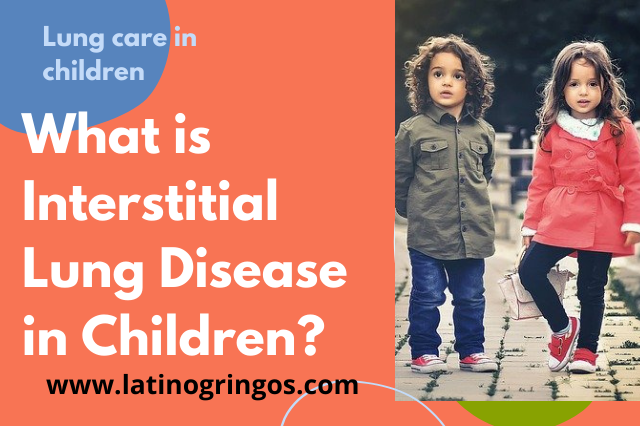What is Interstitial Lung Disease in Children?
(chILD) is a group of rare lung diseases found in infants, children, and teens. There are many types of chILD. The different types of ChILD can have some of the same symptoms. The symptoms, however, may vary in how severe they are.
Here at Latino Gringos™ we have carried out extensive research to determine how important it is to take care of the lung development of infants because lately many studies have shown that certain pathologies acquired by Latinos in their childhood can have long-term repercussions on the health of The same.
What are the types of (chILD)?
Examples of types of chILD:
■ Bronchiolitis Obliterans
■ Chronic Bronchiolitis
■ Connective tissue associated lung disease
■ Cryptogenic Organizing Pneumonia (COP)
■ Alveolar Capillary Dysplasia with misalignment of the pulmonary veins
■ Hypersensitivity Pneumonitis
■ Capillaritis
■ Neuroendocrine Hyperplasia of Infancy (NEHI), also known as Persistent Tachypnea of Infancy
■ Pulmonary Interstitial Glycogenosis (PIG)
■ Surfactant dysfunction mutation
What are the common signs and symptoms of (chILD)?
■ Fast breathing (tachypnea)
■ Working hard to breathe
■ retractions (use of muscles between the ribs or in the neck when breathing)
■ Chronic cough
■ Abnormal lung sounds heard with a stethoscope, such as wheezing or crackles
■ difficulty breathing when exercising
■ Coughing up blood (hemoptysis)
■ Frequent episodes of bronchiolitis and/or pneumonia
■ Respiratory failure
■ Poor weight gain or growth (failure to thrive)
■ Clubbing(abnormal enlargement of the tips of the fingers/ toes)
■ Low oxygen levels (hypoxemia) at rest, with sleep, and/or with exercise
■ Abnormal findings were seen in the lungs on chest x-ray or chest CT (computerized tomography) scan
■ Abnormal lung function tests
How is (chILD) diagnosed?
Often, (chILD) can be diagnosed with a lung biopsy. Your child will be given general anesthesia so he or she will be asleep and will not feel anything during the lung biopsy. A surgeon makes a small incision between the ribs and removes a small piece of lung tissue. A pathologist examines the tissue and looks for patterns in the lung tissue that might match with a certain type of chILD.
Action Steps
If your child has unexplained lung problems or does not respond to treatment for common problems, see a pediatric lung specialist doctor. If your child has (chILD),
√ Take action to prevent illness by washing hands, avoiding sick people.
√Avoid exposure to air pollution and smoke.
√Give extra oxygen as needed to reduce stress on the lungs and body.
We at Latino Gringos™ hope you like this article, please share with family and friends and visit our website at www.latinogringos.com
Cuidado pulmonar en los niños
¿Qué es la enfermedad pulmonar intersticial (chILD)?
(chILD) es un grupo de enfermedades pulmonares raras que se encuentran en bebés, niños y adolescentes. Hay muchos tipos de (chILD). Los diferentes tipos de (chILD) pueden tener algunos de los mismos síntomas. Sin embargo, los síntomas pueden variar en cuanto a su gravedad.
Aquí en Latino Gringos™ hemos realizado una amplia investigación para determinar lo importante que es el cuidar del desarrollo pulmonar de los infantes, pues últimamente muchos estudios han arrojado que ciertas patologías adquiridas por los latinos en su infancia pueden tener repercusiones a largo plazo en la salud de los mismo.
¿Cuáles son los tipos de (chILD)?
Ejemplos de tipos de NIÑO:
■ Bronquiolitis obliterante
■ Bronquiolitis crónica
■ Enfermedad pulmonar asociada al tejido conectivo
■ Neumonía organizada criptogénica (COP)
■ Displasia capilar alveolar con desalineación de las venas pulmonares
■ Neumonitis por hipersensibilidad
■ Capilaritis
■ Hiperplasia neuroendocrina de la infancia (NEHI), también conocida como taquipnea persistente de la infancia
■ Glucogenosis pulmonar intersticial (PIG)
■ Mutación por disfunción del surfactante
¿Cuáles son los signos y síntomas comunes de (chILD)?
■ Respiración rápida (taquipnea)
■ Trabajando duro para respirar
■ Insuficiencia respiratoria
■ Poco aumento de peso o crecimiento (retraso del crecimiento)
■ Clubbing (agrandamiento anormal de las puntas de los dedos de manos / pies)
■ Niveles bajos de oxígeno (hipoxemia) en reposo, al dormir y / o al hacer ejercicio
■ Se observaron hallazgos anormales en los pulmones en la radiografía de tórax o la tomografía computarizada de tórax.
■ Pruebas de función pulmonar anormales
¿Cómo se diagnostica (chILD)?
A menudo, (chILD) se puede diagnosticar con una biopsia de pulmón. A su hijo se le administrará anestesia general para que esté dormido y no sienta nada durante la biopsia de pulmón. Un cirujano hace una pequeña incisión entre las costillas y extrae un pequeño trozo de tejido pulmonar. Un patólogo examina el tejido y busca patrones en el tejido pulmonar que puedan coincidir con cierto tipo de niño.
Pasos de acción
Si su hijo tiene problemas pulmonares inexplicables o no responde al tratamiento de problemas comunes, consulte a un pediatra especialista en pulmones. Si su hijo tiene (chILD),
√Tome medidas para prevenir enfermedades lavándose las manos, evitando a las personas enfermas.
√Evite la exposición a la contaminación del aire y al humo.
√Administre oxígeno adicional según sea necesario para reducir el estrés en los pulmones y el cuerpo.
En Latino Gringos ™ esperamos que le guste este artículo, por favor comparta con familiares y amigos y visite nuestro sitio web en www.latinogringos.com








